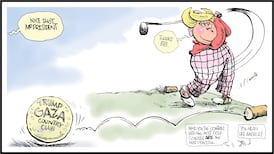The disturbances at Dunsink Lane have borne more resemblance to the American Wild West than a civil protest in a suburb of Dublin city. There have been nightly reports of arson attacks, petrol bombs, stone-throwing, missiles and threatening and intimidating behaviour since a group of Travellers mounted a protest about the erection of a concrete barrier to block vehicular access to Dunsink Lane.
The Garda Síochána came out in force: 200 members to monitor 160 protesters on one night, as well as members of the Garda Public Order Unit, Garda transit vans, riders from the Garda Mounted Unit and a helicopter from the Garda Air Support Unit on other nights.
Dunsink Lane was turning into a "no-go area" in the capital with allegations of discrimination and racism competing for legitimacy. The descriptive report by Paul Cullen in today's newspaper captures yesterday's scene. "This is our Garvaghy Road", said one member of a Traveller family, asserting his right to shop locally and bring the children the normal way to school. But the situation on the ground is not quite that simple.
Dublin City and Fingal councils decided to build a concrete barrier to block the Dunsink Lane through-road to Finglas because of concerns by State agencies - gardaí, customs officers and waste-enforcement staff - about the level of criminal activity and illegal dumping in the area. They did not consult the local community. The result was that the residents of Dunsink Lane had to drive eight miles to go to their normal shops and school because vehicular access to Finglas was blocked.
Most, if not all, of these local residents, however, happened to be Travellers. For two miles of the stretch of lane, there is an official halting site, an estate of small houses also occupied by Travellers, and mobile homes and caravans. The local councils clearly would have known that the building of the barricade would have affected Traveller families disproportionately, if not exclusively. The Minister of State for Housing, Mr Noel Ahern, who is also a local TD, defended the decision to close off the lane as "the only option" to clamp down on alleged illegal activity in the area, such as diesel-laundering. It was not taken lightly but after a list of troubles over the last two years.
In today's politically correct Ireland, it is very easy to allege "racism", without substance. The representatives of the Travellers have been remarkably silent about anti-social behaviour in their communities over the years. It is easier still to allege that all Travellers want rights without the responsibilities of the settled community. That argument is also simplistic. But, legitimate questions are raised about the nature of our society by the disturbing events at Dunsink Lane. The building of a concrete barricade, without consultation with the community, was a very crude instrument of public policy. And the local State agencies and councils should have known it.









